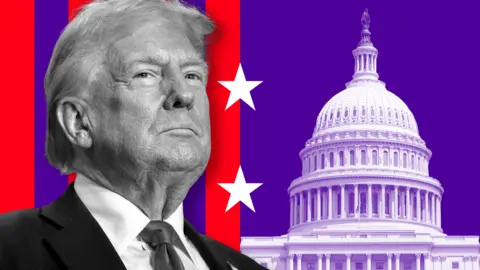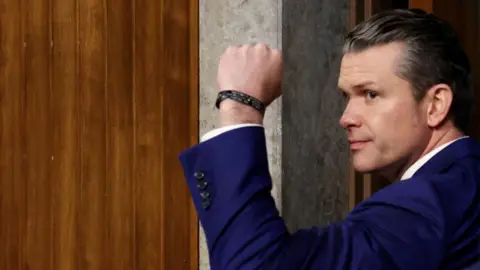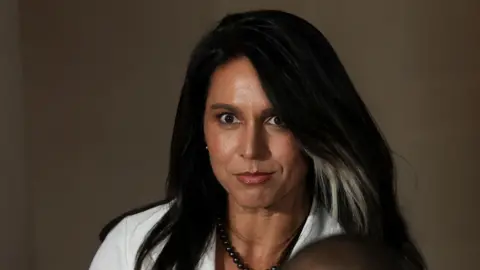 BBC
BBCDonald Trump loves performing and he loves surprising people.
And as he returns to the White House, the world waits to see whether Trump 2.0 will truly be a more disciplined and effective version of his previous, chaotic incarnation.
But even before he returns to the Oval Office, the biggest difference between now and the start of his first term eight years ago is how bold he feels.
In talking to people around Trump, trust is unavoidable. He has the Republican Party in line, the business community scrambling to donate money to his inauguration, and an exhausted and largely silent opposition.
The election was actually pretty close, but you wouldn’t know that in the Maga world. They feel vindicated and want to act quickly to get things done, strike back at the new president’s enemies, and change America. They believe the country supports Trump’s contempt for “woke” agendas, the mainstream media, and global elites.
And the agenda reflects it. From mass deportation of migrants and pardons for Capitol rioters, to punitive trade tariffs on America’s neighbors and an end to birthright law, many fundamental changes are promised and he could announce many of them as soon as possible. the first day.
The effect would be dizzying – and that’s the point.
 Reuters
ReutersThe team Trump will bring to the White House reflects this boldness. Gone is the president who seemed impressed by establishment hierarchies and credentials.
Make his choice for Secretary of Defense.
In 2016, Donald Trump chose Jim Mattis to lead the Pentagon, almost mocking the longtime general “whom everyone loves.”
He praised Mattis as “a man of character and integrity.” (Two years later, Mattis would resign amid very public differences of opinion and Trump would call him “the most overrated general in the world.”)
Fast forward to 2024 and Trump has chosen a very different Secretary of Defense: Pete Hegseth is a television host with a military background but no significant management experience, who appears to have survived his Senate confirmation hearings despite multiple accusations of sexual abuse and drunkenness.
Trump has no intention of impressing anyone this time, and the Republican Party appears to have neither the ability nor the interest to provide checks and balances on his instincts. Trump standing by Hegseth as the scandal swirled was apparently a test for Republican lawmakers. Would they dare to challenge Trump? They didn’t do it.
So, for the moment, unity exists – but if we look beneath the surface, there is less harmony, and with it the prospect of greater chaos.
Trump’s cabinet is made up of a team of people with surprisingly different opinions who don’t always get along well.
His choice to lead health care, Robert F. Kennedy Jr., is a former pro-choice Democrat at a time when many Republican lawmakers want to restrict access to abortion.
Treasury Secretary nominee Scott Bessent embodies old-school Republican economic values and comes from Wall Street after working for liberal financier George Soros. But Trump’s vice president, JD Vance, is a populist who says “we’re done with Wall Street.” There’s Elon Musk, with his deregulation agenda, alongside a candidate for Secretary of Labor who favors unions and worker safety regulations.
Trump’s choice for secretary of state, Marco Rubio, is in the conventional, hawkish Republican mode. He called Vladimir Putin a “thug” and a “gangster.” Meanwhile, Trump’s choice for director of national intelligence, Tulsi Gabbard, who sympathized with US adversaries including Russia and now-deposed Syrian leader Bashar al-Assad, and who was described by a Trump ally as a pacifist, “the Jimmy Carter” of the group.
 Reuters
ReutersAllies of the new president say this unconventional mix of views is what makes Trump different and exciting. A former Trump adviser told me that the uniformity of opinion in previous Democratic administrations was like “a flock of parrots.” According to this advisor, the goal of Trump’s second term is to shake up a stultifying system of government.
Historian Doris Kearns Goodwin credited Abraham Lincoln with creating a cabinet composed of a team of his rivals. In Trump’s case, this new administration is more like a court than a republic. The courtiers have differing views and disagreements with each other and they must get as close as possible to the man at the center of it all for their agenda to prevail.
They know Trump’s reputation for agreeing with the last person who has his ear, and in the White House’s first term, officials fought to be that influential person. When that failed, they often went to the press to try to get their opinions heard.
With so many competing opinions, there could be even more leaks this time around, despite the best efforts of new chief of staff Susie Wiles.
The key question for this administration, then, is whether this surprisingly eclectic group will be able to fix the problems and produce the best possible outcome. Or if the cabinet seems like a brawl of enthusiastic students fighting and obstructing each other in an effort to become the teachers’ darling, with no clear principles to guide them.
The already visible lack of cohesion worries some analysts, particularly in matters of national security. “There is no consensus within the new administration on how China is perceived,” says Richard Haass, who worked in the Bush administration and is now president emeritus of the Council on Foreign Relations. “We can expect ongoing struggles over American policy and plenty of inconsistencies.”
For now, Trump’s desires reign supreme. But the president knows that in just two years America will have a congressional midterm election and the conversation will quickly turn to the future. The Republican train will leave the station and President Trump will remain standing on the platform.
He will still have influence and a lot of money which will give him some power over the succession, but the conversation will continue and the courtiers will compete for power themselves.



